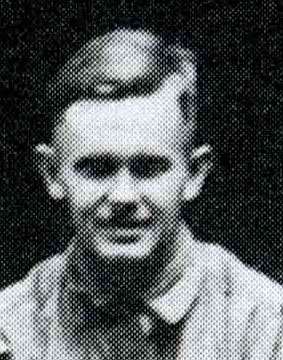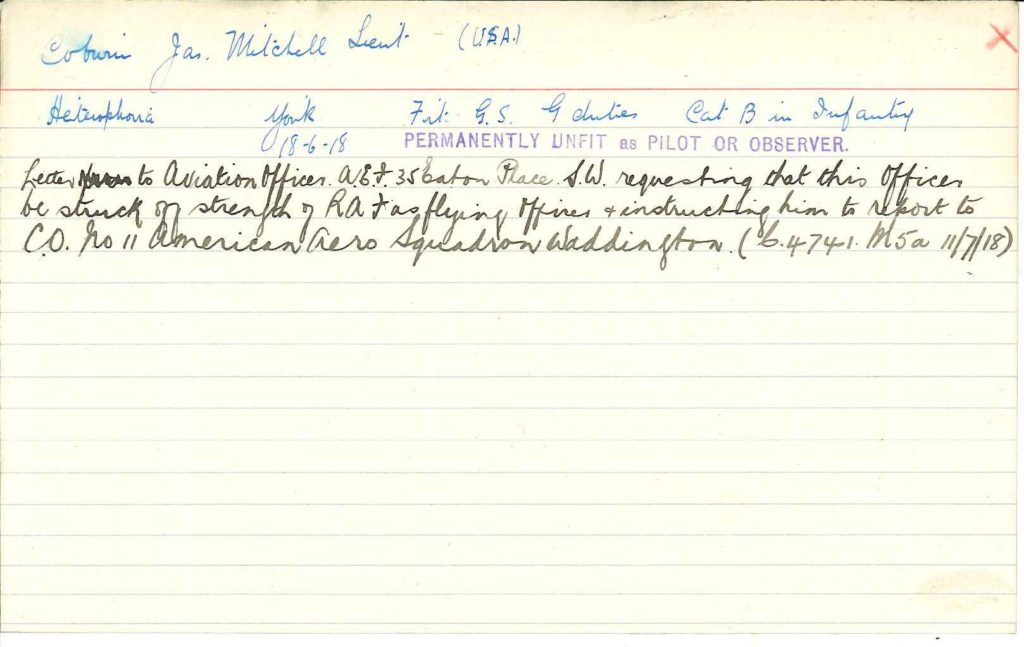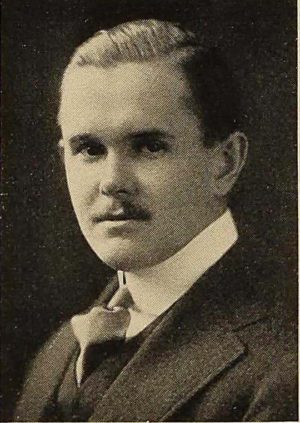(Independence, Missouri, June 13, 1892 – Siloam Springs, Arkansas, May 17, 1968).1
Like his fellow second Oxford detachment member Bulkley, Coburn could trace the male line of his family back to a Puritan immigrant; Peter Coburn arrived in New England in 1635. A family history notes that “The Coburns . . . have been represented in every war since their arrival in this country.” Coburn’s father was born in Dracut, Massachusetts, where his Puritan ancestor had lived and died, but by 1880 had settled with his family in Kansas City, where he pursued banking and cattle interests.2
Coburn attended Culver Military Academy in Indiana before enrolling at the University of Kansas. After a year he transferred to Yale and graduated from Sheffield Scientific School, class of 1914, with a Ph.B.3 When he registered for the draft in 1917 he was working as a mechanical engineer at the Kansas Radiator Company.

Coburn was a member of the ground school class at the University of Illinois that graduated August 25, 1917.4 About one third of the men in this class, including Coburn, chose or were chosen for flight training in Italy and sailed with the 150 men of the “Italian” or “second Oxford detachment” to England on the Carmania. They departed New York on September 18, 1917, and, after a stopover at Halifax to meet up with a convoy for the Atlantic crossing, docked at Liverpool on October 2, 1917. Here they learned that they were not to go on to Italy, but would remain in England and attend ground school (again) at the Royal Flying Corps’s No. 2 School of Military Aeronautics at Oxford University. A month later, on November 3, 1917, most of the detachment, including Coburn, went to Grantham in Lincolnshire to attend machine gun school at Harrowby Camp. Fifty of the men were then selected in the middle of November to go from Grantham to flight training squadrons, but Coburn was among those who remained at Grantham through Thanksgiving and the end of November.5

Finally, on December 3, 1917, the remaining men were posted to flying squadrons, and Coburn went with eleven others (Blackburn, Cunningham, Lavalle, Martz, McCarthy, McCurry, Merrill, Nial, Stanbery, Wells, and Young) to No. 61 Squadron at Rochford in Essex.6 This was a home defense squadron flying S.E.5a’s, but presumably there were also older planes used for training.
There is a sketchy R.A.F. service record for “James M J [sic; sc: Jr.?] Coburn” that indicates that he was at No. 51 Training Squadron (Waddington); no dates are provided.7 William Ludwig Deetjen wrote in his diary on March 23, 1918, that “Wednesday I ran over to Nottingham, where Jake Stahl, Jim Coburn and I dined together at the Victoria Hotel.” It is reasonable to suppose that Coburn was visiting Nottingham while stationed at Waddington. And, from an account in a letter written by Vincent Paul Oatis on April 14, 1918, it is apparent that he and Coburn were at Waddington together during the last Zeppelin raid on Britain two days previously. “I had just snuggled into bed for a good sleep, when from far away I heard a low rumble. Jim Coburn called out ‘Vince! Did you hear that?’ Before I could answer ‘Bang!’ went another. There was no use arguing the point, so we got up, jumped into some clothes (without a light I might add) and went outside for a look around.” They spent a very uneasy night, but found the next morning that little damage had been done.6a
Coburn was one in a long list of men from the second Oxford detachment whose recommendations for commissions as first lieutenants “non-flying” were forwarded to Washington by General Pershing in a cablegram dated April 8, 1918. In an earlier cable to Washington, dated March 13, 1918, Pershing had described the situation of the approximately 1400 aviation cadets in Europe, some of whom had waited three months to start flying instruction, and some of whom, after five months, were still waiting and might have to wait another four. “All of those cadets would have been commissioned prior to this date if training facilities could have been provided. These conditions have produced profound discouragement among cadets.” To remedy this injustice, and to put the European cadets on an equal footing with their counterparts in the U.S., Pershing asked permission “to immediately issue to all cadets now in Europe temporary or Reserve commissions in Aviation Section Signal Corps.” Washington approved the plan in a cable dated March 21, 1918, but stipulated that the commissioned men be “put on non-flying status. Upon satisfactory completion of flying training they can be transferred as flying officers.”8
Coburn was presumably one in a handful of men from the thirty-eight second Oxford detachment members named in Pershing’s cable of April 8, 1918, who were not “transferred as flying officers,” although his commission was among those approved in a cablegram from Washington dated May 13, 1918.8a On June 18, 1918, a medical exam resulted in his being declared “Perm[anently]. Unfit as P[ilot]. or Obs[erver]. York” (as noted on his R.A.F. service record). A medical card indicates that on that date he had been diagnosed with heterophoria, an eye defect that would have interfered with depth vision and that was of particular concern as it had “been found to be a cause of making bad landings.”8b A further note on the card indicates that he was instructed, apparently on July 11, 1918, to report to the C.O. of “No 11 American Aero Squadron” at Waddington.

The men of the 11th Aero by this time had become proficient enough in maintaining various aircraft and motors that they were now serving as instructors. An organization chart includes a twenty-seven man engineering department headed by an “Engineering Officer,” and perhaps it was in such a capacity that Coburn was now expected to serve (but he does not appear in personnel lists of the 11th).9 A post-war biography indicates that he served as an engineering officer in charge of airplane repair shops.10
On returning to the U.S., Coburn pursued his interest in aviation, initially in Kansas, then in New York, where for a time he taught aeronautics at N.Y.U. During World War II he served as a consultant to the Air Materiel Command at Dayton Ohio.11 Together with Peter H. Redpath he wrote Air Transport Navigation for Pilots and Navigators, published in 1943.
mrsmcq June 6, 2017
Notes
(For complete bibliographic entries, please consult the list of works and web pages cited.)
1 For his date and place of birth, see Ancestry.com, U.S., World War I Draft Registration Cards, 1917-1918, record for James Mitchell Coburn Jr. (Note: the registration form is not dated but gives his age as 24.) The photo is taken from Bryan, James T. et al., eds., Class history 1914 Sheffield Scientific School Yale University, p. 146.
2 See Coburn and Gordon, Genealogy of the Descendants of Edward Colburn / Coburn, p. 278, where descendant no.809 is James Mitchell Coburn, Sr.; and p. 3, regarding the family’s military prowess. See Ancestry.com and The Church of Jesus Christ of Latter-day Saints, 1880 United States Federal Census, record for Jas. M. Coburn, for his residence in Kansas City and occupation as a bank cashier; see Ancestry.com, 1900 United States Federal Census, record for James M Coburn, where his occupation is given as cattle dealer.
3 Bryan et al. eds., Class history 1914 Sheffield Scientific School Yale University, p. 146; for Coburn’s degree (sometimes mistaken for a Ph.D.), see Senior Classes, University College and College of Engineering, New York University, University Heights, 1939 Violet, p. 47.
4 “Ground School Graduations [for August 25, 1917].”
5 Foss, Diary, entry for November 15, 1917, lists the men chosen.
6 Foss, Papers.
6a Oatis, letter of April 14, 1918. For details of this raid, see Castle, Zeppelin Raids, Gothas and ‘Giants.’ See also Payden’s brief account of the raid in “Leaving Soon on Tour of World.”
7 The National Archives (United Kingdom), Royal Air Force officers’ service records 1918-1919, record for James M J Coburn.
8 Cablegrams 874-S (April 8, 1918), 726-S (March 13, 1918), 955-R (March 21, 1918).
8a Cablegram 1303-R.
8b Anderson, The Medical and Surgical Aspects of Aviation, p. 31.
9 “11th Squadron,” pp. 2–6. And see the rosters of enlisted men and officers on pp. 202-07 of History of the 11th Aero Squadron U.S.A.
10 Nettleton, Yale in the World War, vol. 2, p. 387.
11 “Dr. James Coburn, Jr.”

